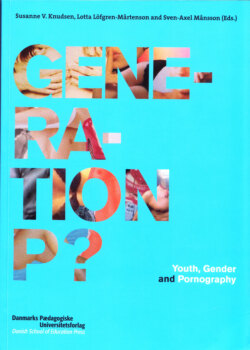Читать книгу Generation P? - Группа авторов - Страница 11
На сайте Литреса книга снята с продажи.
Mainstreaming of pornography – ‘porno-chic’
ОглавлениеThe term that best describes the current position of pornography in our culture is mainstreaming’. In his books, the English media researcher Brian McNair has frequently examined a related phenomenon which is referred to as ‘porno-chic’ in media research (McNair 1996, 2002). The term mainstreaming’ denotes the cultural process whereby pornography imperceptibly becomes part of our everyday life, as a generally accepted and often idealised cultural element. Three phenomena work together in this process. The first is the increasing volume, which pertains to the increasing quantity of pornography, its more frequent display, and its ease of access. Thus, to find pornography, one no longer needs to sneak into particular cinemas or specialty shops; one can watch porn on late-night TV (even on non-commercial channels) and find pictures or watch web-cam transmitted porn on the internet all day. If one wants to consume pornography, one is no longer limited to particular times or places. Nor is one subjected to the shaming and scornful gazes of the public, since the consumption may take place anonymously. Simultaneous with these changes is the process of clean-up, which means that genuine pornography is slowly becoming acceptable. This is taking place because of the mass media’s growing interest in this field and is to be seen in different genres and media, such as documentaries on TV, popular magazines that make references to web sites on the internet, reviews of ‘porn magazines’ and articles that cover a wide range of pornographic topics, from life as a stripper or a customer of prostitution to reviews from the SM-clubs. A recent example of this phenomenon in Denmark is Danish ex-porn star Katja Kean’s autobiography about her life in the international porn business (Kean & List 2002).
When the mass media handle pornographic material, they operate – often unconsciously – in a schismatic field between‘shymodesty’ and ‘liberated matter of course’. The motives given for covering such topics were initially formulated as a sort of public service to satisfy the public’s demand for information on and documentation of the shady sides of society. More recently, however, it seems that the motives have more to do with an eagerness to challenge and relocate boundaries. The argument that it is acceptable to express and show certain things that may be conceived as transgressions is present both explicitly and implicitly, and it is implied that one’s acceptance is an indication of broad-mindedness and a liberal attitude.
The Danish youth magazine Tjeck, which targets both genders, is financed by the labour movement and is distributed free to all young members of trade unions, has been part of the porn chic movement since the late 1990s. In February 2002 the magazine published the article “Snoop Doggy Dogg – I have fucked one million ho’s”which is a significant example in support of the statement above. At first, it seems to thematise the ethical dilemmas associated with pornography by telling the story of a young man’s moral agony connected to buying a hardcore pornographic video produced by Snoop Doggy Dogg. Quite soon, however, one discovers that the topic instead concerns the ‘fascination of porn’ and that the purpose of the article is to legitimize and normalize the consumption of pornography. This is done by explicit ridicule of the main arguments of the critics of pornography and is underscored by detailed information about places where the video is fore sale
The article is crammed with pictures from the pornographic film, and some of the captions, which are quotations from the film, are: “Way to go. Come closer, then we’ll pull down our knickers and show daddy parts of the pink!” “Does it tickle you? Do you like it? What do you say? Would you rather have a taste of daddy’s pounding organ? So, help yourself”. (Tjeck Magazine 2002/123).
A third phenomenon associated with the so-called ‘porno-chic’ or ‘the mainstreaming of pornography’ is that fragments of pornography gradually become parts of the mass culture. Commercial posters, music videos, TV-documentaries, fashion reviews, and magazines (particularly youth magazines) increasingly use signs, symbols, aesthetic features or verbal statements which themselves are not pornography, but clear references to pornography. Examples are the poses fashion models adopt in fashion reportage, their clothing, their movements, their surroundings, or the statements they make. Thus the autumn 2001 catalogue from the Benetton-owned clothing company Sisley featured a series of pictures inspired by the theme in the hay with animals. The pictures are strongly sexual with obvious references both to sexual preferences such as animal-sex, and to classic pornographic scenarios. In one of the illustrations, the caption refers “the money shot” or the “cum shot’ in pornographic terminology. The fashion catalogue rephrases the cum-shot in the image of a young woman who squirts milk from a cow’s udder in her mouth. The milk runs out of her mouth and downward on the ground while she stares at the viewer in concordance with the look that the porn model directs to the imagined viewer in a classic porn production.
